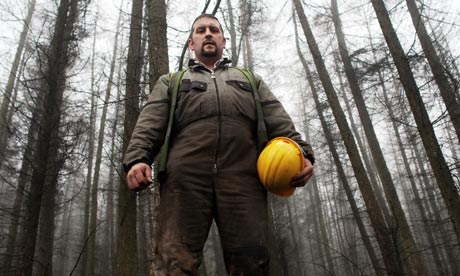After destroying millions of oaks in California, the infection spread to Britain – then suddenly jumped species

Jason Hill among larches he is cutting down in Afan Valley: “I was due to be coming here to thin this lot, but now we’re flattening them all; it’s shocking.” Photograph: Gareth Phillips for the Observer
Through the mist and mud, Jason Hill reaches the forestry machine and climbs in to start the engine. “It’s really something I don’t want to be doing,” he says. “But if I don’t do it, somebody else will. It’s devastating.”
Seated at the computer controls, he operates a mechanical arm which grips a 30ft tall larch and slits through its base. Swinging it to the horizontal, the arm strips the tree down to a denuded trunk and slices it into even lengths of log that drop heavily into a pile. The process takes only minutes before the machine turns to the next tree.
In woodlands around the UK, just as here in Afan Valley, south Wales, the race is on to fell thousands of trees in a desperate effort to contain a new disease which poses a threat to British forests on a scale not seen since Dutch elm disease wiped out millions of trees, changing the landscape of the country for ever.
Already 3,000 hectares of larch forest – one hectare is about the size of a football pitch – in Wales, Devon, Cornwall, Somerset and Northern Ireland are known to be infected by Phytophthora ramorum – sudden oak death – which comes from the same family as the potato blight organism that caused the Irish famines in the 19th century.
Named in the United States, where it has killed millions of oak trees in California, the strain now in the UK had never been seen before by science before it was detected in imported shrubs in a Sussex nursery in 2002.
In 2003, it turned up in a handful of oaks, but they seemed to have resistance and the outbreak did not seem to be too worrying. Then last year, taking everyone by surprise, the phytophthora jumped species and rapidly began infecting and killing the commercially important Japanese and European larch trees. It has also been found in several conifer species, including Douglas fir. Now the battle is on to stop it.
“I don’t want to scaremonger, but we are very worried,” said Roddie Burgess, the head of plant health at the Forestry Commission.